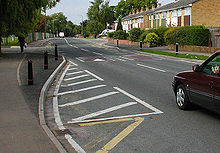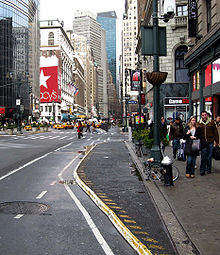- Curb extension
-
 A curb extension marked by darkened tarmac and black posts.
A curb extension marked by darkened tarmac and black posts.
A curb extension (or also neckdown, kerb extension, bulb-out, kerb build-out, nib, elephant ear, curb bulge,"curb bulb" and blister) is a traffic calming measure, primarily used to extend the sidewalk, reducing the crossing distance and allowing pedestrians about to cross and approaching vehicle drivers to see each other when vehicles parked in a parking lane would otherwise block visibility.
A curb extension is an angled narrowing of the roadway and a widening of the sidewalk (pavement or footway in UK usage). This is often accompanied by an area of enhanced restrictions (such as a "no stopping" or "no parking" zone) and the appropriate visual reinforcement. This is achieved using painted road markings (e.g. lines, coloured areas, or chevrons), barriers, bollards, or the addition of pavement or street furniture (e.g. planters, lamp standards, or benches).
Curb extensions are often used in combination with other traffic calming measures such as chicanes, speed bumps, or rumble strips, and are frequently sited to "guard" pedestrian crossings. In these cases the "squeeze" effect of the narrowed roadway shortens the exposed distance pedestrians must walk.
Contents
Uses
The primary use of curb extensions are to improve visibility of pedestrians and reduce their exposure to motor vehicles.
Curb extensions are also in a number of special circumstances:
- To provide additional horizontal space to allow retrofitting of existing sidewalks with ramps, where the sidewalk would otherwise be too narrow.
- To provide additional visibility and protection for pedestrians (particularly children) when leaving premises. The curb extension may contain a pedestrian barrier, preventing pedestrians from running straight from the premises over the road.
- In combination with a controlled urban parking scheme, where parking spaces are shielded from oncoming traffic by the extended sidewalk element.
- To slow and calm traffic, particularly fast traffic turning from a major to a minor road.
- To protect passengers embarking and particularly disembarking from trams, buses, and level-grade urban light rail systems, particularly when retrofitting existing streets.
Curb extensions are also used when retrofitting existing streets to accommodate congestion charging schemes - hitherto wide (sometimes multi-lane) roads are deliberately narrowed to ensure that the charging equipment can see passing vehicles, and the charging equipment (and often bollards or other barrier devices) are placed in the expanded sidewalk area (to prevent drivers from circumventing the charging system's cameras and detectors).
Design, advantages and disadvantages
The Pedestrian and Bicycle Information Center states that curb extensions must not encroach on travel lanes, bicycle lanes, or shoulders, and should not extend more than 1.8 m (6 ft) from the curb. [1] Some curb extensions are built with the bike lane passing through (making the extension an island, separated from the main sidewalk by a narrow bike lane).
One study has found that pedestrians crossing at curb extensions have to wait for fewer vehicles to pass before a motorist yields to allow them to cross. The study was too small to determine whether other measures of effectiveness, such as percent of pedestrians crossing after a motorist yields, were significant. [2]
Poorly designed curb extensions can pose a hazard to cyclists, as they force cyclists from their position at the road side (or in a roadside bike lane) into the narrowed gap. They can also damage vehicles if the curbs extend too close to traffic lanes. [3]
Curb extensions have not been found to affect the speed of vehicle traffic.[4]
Author Randal O'Toole argues that curb extensions are used to increase traffic congestion to discourage the use of automobiles by reducing the number of lanes available for automobiles. In particular, curb extensions can be used to block turn lanes, forcing turning vehicles to remain with the forward moving traffic.[5] Curb extensions do prevent drivers from using parking lanes or shoulders as right turn lanes.
However, reducing the crossing distance also reduces the time needed to cross the street. This allows a reduction in the length of the pedestrian phase at signalized intersection, and reduces the time needed to yield to pedestrians at stop sign controlled intersections. This at least partially compensated for any loss in vehicle capacity. [6]
Curb extensions complicate drainage. They obstruct the gutter, so a catch basin is needed at the uphill end to keep a puddle from forming. An alternate solution is placing a gap in the curb, allowing the stormwater in the gutter to irrigate a rain garden in the curb extension.[7]
Broadway at 33rd Street, Manhattan.
To facilitate street sweeping, the internal and external curvatures of the extended curb section are moderately graduated.
Retroactively adding curb extensions to older, established communities has been controversial in some instances, due to the installation of the extensions reducing the availability of on-street parking for some properties, particularly in cases where the curb extension has been installed on its own and not in conjunction with a crosswalk.
See also
- Bus bulb / boarder, a specific type of curb extension that is used as a bus stop
References
- ^ Pedestrian and Bicycle Information Center, "Crossing Enhancements," http://www.walkinginfo.org/engineering/crossings-enhancements.cfm, retrieved 6/23/2010
- ^ Randal S. Johnson (July, 2005). "Pedestrian Safety Impacts of Curb Extensions: a Case Study". http://www.oregon.gov/ODOT/TD/TP_RES/docs/Reports/PedestrainSafetyCurbExt.pdf?ga=t. Retrieved 8/5/2011.
- ^ Albany Times Union "MOTORISTS TAKE HIT ON ROAD PROJECT" July 19, 2004, http://albarchive.merlinone.net/mweb/wmsql.wm.request?oneimage&imageid=6245046 retrieved 6/29/2010
- ^ Pedestrian and Bicycle Information Center, "Do curb extensions reduce speeds", http://www.bicyclinginfo.org/faqs/answer.cfm?id=3453, retrieved 6/23/2010
- ^ Randal O'Toole "Gridlock"
- ^ "Road Diets: Making Streets Slim Down Is Good For Pedestrians, Businesses And Even Traffic," Planetizen, http://www.planetizen.com/node/44645
- ^ Sustainable Stormwater Management, http://www.portlandonline.com/BES/index.cfm?c=34598, retrieved 4/28/2010
External links
- Transport SA (South Australia) explanation of curb extensions
- Portland Dept. of Transportation - document showing curb extensions and the circumstances of their use.
- WalkingInfo.org's detailed discussion of curb extensions
- Information and policy from Kingston, Ontario
Categories:
Wikimedia Foundation. 2010.

